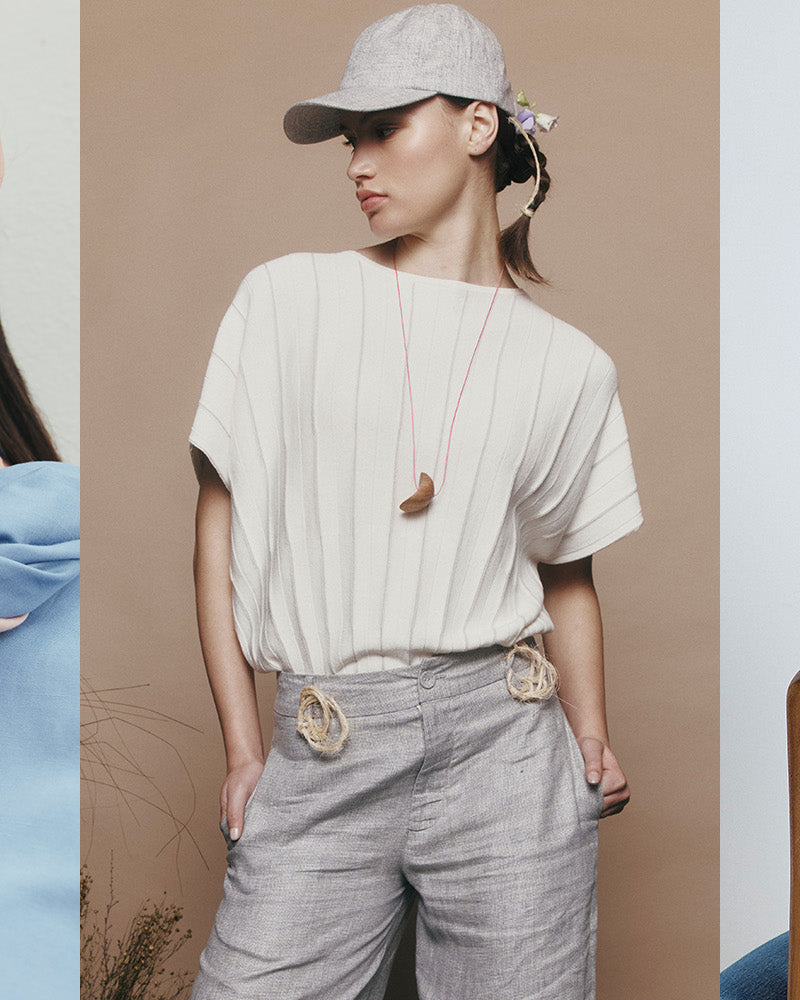Before we even pick up our knitting needles, our story begins at the source of our fibres. Cotton fields, wool farms, high country stations and the production of synthetic materials — each thread has a beginning, a story, and a footprint. The journey from field to fabric can be resource-intensive, and understanding the impact of these raw materials is key to our commitment to sustainability.
This week, we discovered that there is 20% nylon in our Ecopossum and Rubbish socks. After initially feeling disappointed and confused, it got us thinking deep and hard about the complexity of sustainable supply chains.
Over the last 40 years we have had the privilege of pioneering this movement towards ecological and sustainable products. We have developed beautiful products that have shifted and pushed the boundaries of what ethical fabrics can do. We have done this through a deep relationship with our supply chain and the people who make our clothes. We have and never will, proclaim to be perfect. For us, it’s about keeping a positive and curious mindset, to question and push things forward.
To claim that something is sustainable, you must first know where it is from. Discovering the origin of our garments is easy, we see them made daily in our workrooms at 155 Roydvale Ave, Christchurch. However, sourcing the origin of fibres is incredibly complex.
61% of brands don’t know who made their clothes.
93% of brands don’t know who made their fabrics.
Unlike most brands, we know where all our fibres come from. In the case of our socks, we send our 100% natural yarn blend to our sock makers to turn into socks. Whilst we knit most our range at our workrooms, we don’t have the machinery for this product. What we didn’t realise was that a carrier nylon thread is knitted in when our socks are made. As time goes on, (years and years in our case) factories can change processes, people, and ways of doing things. We found out from our sock knitter this week (who we have worked with for over a decade) that what we thought was a tiny percentage of nylon at around the top of the sock (not enough to be counted in our fabric composition), actually turns out to be throughout the sock to the tune of 20%.
For most brands this is industry norm. We are not most brands.
We are obsessed with making sure that we are pushing the standard forward. We are also deeply committed to creating lasting change. So rather than play the blame game, we wanted to take this time to explore why nylon is used in socks and make it clear where we stand on it.
What is Nylon?
Nylon is a synthetic polymer or plastic that belongs to the family of polyamides. It was first developed by a team of researchers led by Wallace Carothers, in the 1930s. Nylon is known for its exceptional strength, durability, and versatility, if you check your socks most of them will contain nylon.
What’s the issue with Nylon?
The production of nylon involves the use of petrochemicals, which are derived from non-renewable resources. This contributes to carbon emissions and the depletion of fossil fuels. Nylon is a synthetic (man-made) material and is not easily biodegradable. Once it enters the environment, it exists for a long time, contributing to concerns about plastic pollution.
There is nothing sustainable about a sock with a hole in it.
On discovering this unknown nylon content in our socks, our first response was to request that our sock makers take it out. We were met with a doubtful reply from our sock experts who told us we would not be happy with the quality. Without the carrier thread of nylon or another fibre, your socks would wear quickly, which would mean big holes and little to no longevity. Nylon enhances the strength and durability of wool socks.
Here are some common fibres that are often blended to create strong and durable socks:
- Polyester: another synthetic fibre that can be blended with wool to enhance strength and durability. It provides additional abrasion resistance and helps the socks retain their shape over time.
- Acrylic: a synthetic fibre that is lightweight and durable. Blending wool with acrylic can improve the sock's durability and make it more resistant to stretching and fading. Acrylic also helps the sock maintain its shape.
- Cotton: While not as strong as some synthetic fibres, cotton is a natural fibre that can be blended with wool for added comfort and breathability. A wool-cotton blend is suitable for socks worn in moderate weather conditions.
- Polypropylene: a thermoplastic polymer known for its strength and resistance to moisture. Blending wool with polypropylene can result in socks that are strong, lightweight, and moisture-wicking.
- Spandex or Lycra is a stretchy synthetic fibre that can be blended with wool to add elasticity and ensure a snug fit. This is particularly useful in socks that need to maintain their shape during various activities.
When choosing a blend, we consider the specific characteristics you desire in your socks, such as warmth, breathability, stretch, and durability. The blend ratio will also impact the performance of the sock, so for us it is important to find a balance that suits your preferences and intended use.
The 20%
We’re always learning and while this new knowledge of the nylon content in our socks came as a bit of a shock, we believe in finding the positive in every challenge. We’ve reviewed tightened up our systems, processes and flows with our suppliers to ensure going forward the fabric composition of the final manufactured product is confirmed with every order, that we are fully aware of every fibre that is going into our yarns. For decades our sock maker has simply noted the type of socks we have ordered (merino; or merino and possum) along with the yarn we would send for them. The nylon they add hasn’t been mentioned as far back as we can see, back to the 90’s in fact!
No assumptions. No miscommunications. Clear and honest transparency.
We’ve started sampling nylon free and with nylon just in the heel and toe, so that we can look for an alternative that uses less synthetic, while maintaining our high standard of quality and longevity. We have questioned whether we remove it altogether, however this would create a product that would head to landfill faster.
Durability by Design: A Sustainable Equation
Consider this: A pair of socks that lasts longer, reduces the demand for raw materials and energy associated with frequent manufacturing. In fact, the durability of our socks, due to the inclusion of the nylon, means fewer resources consumed over time. At this moment, everything has an impact. Every choice has an impact.
Our overriding mission is to build the most commercial, groundbreaking, inspiring and trusted natural fibre brand in New Zealand. This means we have to look at what is the industry norm and test it. Push it. Look for innovation.
Let's break it down with some numbers. Studies show that extending the life of a garment by just nine months can reduce the carbon, water, and waste footprint by 20-30%. With the nylon added, we know these socks will last longer.
For us, creating products that stand the test of time and environmental scrutiny is vital. We don’t love how much non-degradable nylon is in our socks, so we’ll be working furiously to minimise its use, without compromising on quality.
We wanted to reach out to you, our community, for help.
Please do get in touch if you know of a fibre that is as strong as nylon but with more aligned environmental impacts.
As always, we love to hear from you. Please connect directly Fiona Bretherton (our development manager) with all your ideas, thoughts and inputs.
Thanks for being on this journey with us to create better and stronger products.
Love, the Untouched World team.















